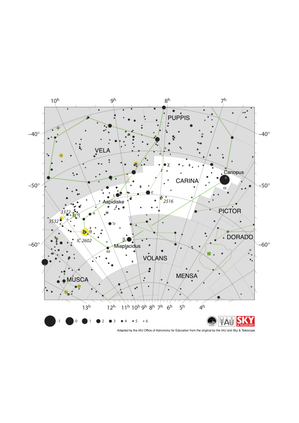Glossary term: Binary Star
Description: A binary star is a system of two stars that orbit around their common center of mass as a result of being bound together by the force of gravity. Their orbits follow Kepler's laws of motion and are elliptical (shaped like a squashed circle) or circular in shape.
More than half of all stars in the Milky Way are in binary systems or part of systems with more than one companion star (known as higher order multiple-star systems). Due to their enormous distances from Earth, most binary stars and higher order multiple-star systems appear to the observer as a single star.
Binaries can be classified into a number of categories according to the observational method by which they were found to be binary stars. They may simultaneously belong to more than one category:
Visual binaries can be observed as two separate stars close together on the sky. Not all stars that appear close on the sky (double stars) are binaries bound by gravity, some may just be close on the sky by coincidence but not bound by gravity. Double stars that are not binary stars bound by gravity can be separated by hundreds of light years in distance.
Spectroscopic binaries are found due to the Doppler shift of the lines in the stars' spectrum as the stars orbit their common center of mass.
Eclipsing binaries can be detected when one of the component stars passes between its companion star and an observer, blocking some of the light from the companion star and causing the combined light of the system to look briefly dimmer.
Astrometric binaries are systems where only one stellar image is observed – either due to one of the stars being too faint to be observed or the two stars' images being blended together – but where the orbital motion of the stars in the binary system causes the brightest point of the stellar image to show a periodic change in position on the sky.
Related Terms:
See this term in other languages
Term and definition status: This term and its definition have been approved by a research astronomer and a teacher
The OAE Multilingual Glossary is a project of the IAU Office of Astronomy for Education (OAE) in collaboration with the IAU Office of Astronomy Outreach (OAO). The terms and definitions were chosen, written and reviewed by a collective effort from the OAE, the OAE Centers and Nodes, the OAE National Astronomy Education Coordinators (NAECs) and other volunteers. You can find a full list of credits here. All glossary terms and their definitions are released under a Creative Commons CC BY-4.0 license and should be credited to "IAU OAE".
If you notice a factual error in this glossary definition then please get in touch.
Related Diagrams
Carina Constellation Map
Credit: Adapted by the IAU Office of Astronomy for Education from the original by the IAU and Sky & Telescope
License: CC-BY-4.0 Creative Commons Attribution 4.0 International (CC BY 4.0) icons









